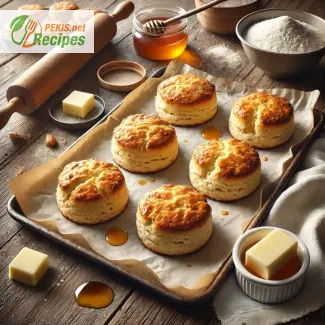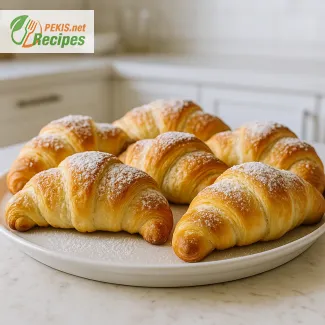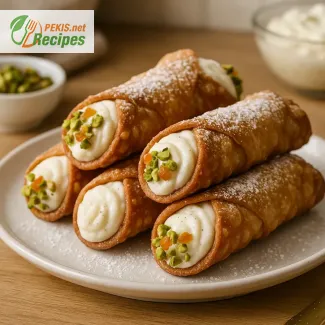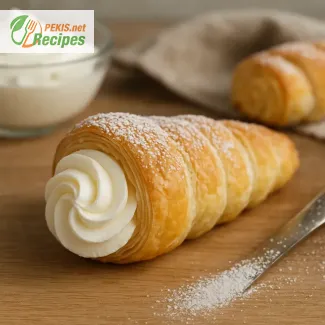
When it comes to comfort food, few dishes capture the essence of Southern American cuisine like traditional buttermilk biscuits. These light, flaky, and irresistibly buttery creations are more than just a breakfast staple; they are a cultural icon that embodies the warmth and hospitality of the South. Whether served as a side to hearty stews, a vessel for sausage gravy, or simply enjoyed fresh from the oven with a pat of butter and a drizzle of honey, these biscuits offer a sensory experience like no other.
The Heart of Southern Hospitality
Buttermilk biscuits trace their roots back to the kitchens of the American South, where resourcefulness and simplicity were key in creating memorable dishes. The combination of basic pantry ingredients—flour, buttermilk, butter, and a touch of baking powder—transforms into a culinary masterpiece with the right technique and care. This simplicity belies the profound richness of their flavor, making them a symbol of comfort and nostalgia for generations.
Texture That Melts in Your Mouth
One bite into a perfectly crafted buttermilk biscuit reveals a contrast of textures: a delicately crisp, golden exterior and a tender, pillowy interior that seems to dissolve effortlessly. Achieving this ideal texture is an art form that Southern bakers have perfected, often passing down their techniques as family secrets. The use of buttermilk, with its tangy flavor and natural acidity, reacts with the leavening agents to create an unparalleled rise and flakiness.
Versatile and Timeless
While traditional buttermilk biscuits are a joy in their purest form, they also lend themselves to endless variations. They can serve as the foundation for savory sandwiches featuring fried chicken, country ham, or fresh tomato slices. On the sweeter side, they pair beautifully with jams, preserves, or whipped cream and fresh berries. Their versatility ensures they remain a cornerstone of Southern cuisine, no matter the occasion.
The Science Behind the Perfection
The magic of buttermilk biscuits lies in the balance of ingredients and the precision of technique. The cold butter, cut into the flour, creates layers of fat that steam in the oven, forming the signature flakiness. Buttermilk adds both moisture and tang, while the right touch of leavening ensures the biscuits rise high and proud. These principles of baking science are what elevate a humble dish into an extraordinary culinary experience.
A Taste of Tradition
Buttermilk biscuits are more than just a recipe; they are a taste of history. They harken back to a time when meals were crafted with care and shared with loved ones around the family table. Even today, they evoke a sense of belonging and community, making every bite a reminder of the importance of tradition and connection.
Bring Southern Charm to Your Table
Whether you're a seasoned baker or a novice in the kitchen, creating traditional buttermilk biscuits is a rewarding experience. The process is as satisfying as the end result: the tactile joy of cutting the dough, the anticipation as they rise in the oven, and the first heavenly taste of warm, flaky perfection.
By incorporating these beloved biscuits into your meals, you're not just enjoying a delicious treat; you're partaking in a tradition that celebrates the heart and soul of Southern cooking. So, roll up your sleeves, preheat your oven, and embrace the charm of traditional buttermilk biscuits—a Southern favorite that never goes out of style.
This description captures the essence of buttermilk biscuits while optimizing for search engines by emphasizing key terms like "Southern American cuisine," "buttermilk biscuits," and "traditional." It appeals to food enthusiasts and beginners alike, highlighting the cultural significance, texture, versatility, and science behind this beloved dish.
- Prepare the dry ingredients:
In a large mixing bowl, whisk together the flour, baking powder, salt, and sugar. This ensures even distribution of the leavening agent and seasoning. - Incorporate the butter:
Add the cold, diced butter to the flour mixture. Using a pastry cutter, two knives, or your fingertips, gently work the butter into the flour until the mixture resembles coarse breadcrumbs. Be careful not to overwork; the butter should remain in small, visible pieces for flakiness. - Add the buttermilk:
Make a well in the center of the flour mixture and pour in the cold buttermilk. Gently stir with a fork or spatula until the dough just comes together. Do not overmix; the dough should be slightly sticky and shaggy. - Shape the dough:
Turn the dough out onto a lightly floured surface. Gently knead it 2-3 times to bring it together, then pat it into a rectangle about 2 cm (¾ inch) thick. Fold the dough in half and pat it out again. Repeat this process 2-3 times to create layers. - Cut the biscuits:
Using a 6 cm (2.5-inch) round cutter, press straight down into the dough without twisting. Place the biscuits on a parchment-lined baking sheet, ensuring they are close but not touching. This helps them rise taller as they bake. - Bake:
Preheat your oven to 220°C (425°F). Bake the biscuits in the center rack for 12-15 minutes, or until golden brown on top. - Serve warm:
Remove from the oven and let cool slightly. Serve warm with butter, honey, or gravy, as desired.
Enjoy the classic comfort of Southern buttermilk biscuits that melt in your mouth while nourishing your body with essential nutrients.
Tips to Enhance Your Traditional Buttermilk Biscuits Recipe
The charm of traditional buttermilk biscuits lies in their simplicity, yet small tweaks and adjustments can elevate this classic recipe to new heights. Whether you're aiming for even flakier layers, richer flavor, or a unique twist, these professional tips will help you achieve perfection while staying true to the soul of this Southern favorite.
1. Perfecting the Dough
- Use cold ingredients:
The key to creating those iconic flaky layers lies in keeping your butter and buttermilk as cold as possible. Cold butter melts during baking, releasing steam that forms layers. For an extra touch of professionalism, chill your flour and mixing bowl before starting. - Don’t overwork the dough:
Overmixing can lead to dense biscuits. Mix the dough just until it comes together. The less you handle it, the more tender your biscuits will be. - Fold for more layers:
Folding the dough multiple times (as outlined in the recipe) creates layers that will separate beautifully when baked. Aim for 3-4 folds to maximize flakiness without overworking.
2. Enhancing Flavor
- Butter quality matters:
Use high-quality European-style butter with a higher fat content. It provides a richer flavor and enhances the texture. - Add a touch of sweetness:
While the recipe includes sugar, you can experiment with slightly increasing the amount (up to 15 g or 1 tbsp) for a sweeter biscuit. Alternatively, use brown sugar for a subtle caramel note. - Infuse the butter:
Before cutting the butter into the dough, try infusing it with herbs (such as rosemary or thyme) or spices (like smoked paprika). Simply melt the butter, add the flavoring, and then chill it until solid before proceeding with the recipe.
3. Adjusting for Texture
- For softer biscuits:
Replace half of the butter with shortening. While butter adds flavor, shortening creates a softer texture. - For crispier edges:
Brush the tops of the biscuits with heavy cream or melted butter before baking. For an extra crunch, sprinkle with flaky sea salt or coarse sugar, depending on your flavor preference. - Experiment with buttermilk ratios:
Slightly reducing or increasing the amount of buttermilk can affect the dough’s moisture content. A wetter dough can yield softer, more tender biscuits, while a drier dough can make them sturdier and ideal for splitting.
4. Baking Techniques
- Preheat the oven fully:
Biscuits require a high initial temperature to achieve their rise and golden crust. Always preheat your oven to 220°C (425°F) and ensure it has reached the correct temperature before baking. - Bake close together:
Placing biscuits close together on the baking sheet encourages them to rise higher. This method traps steam between the biscuits, resulting in a softer texture. - Use a cast iron skillet:
For a truly Southern experience, bake the biscuits in a greased cast iron skillet. This creates a beautifully crisp base while retaining a tender interior.
5. Variations and Additions
- Savory twists:
Mix grated cheese (such as cheddar or Parmesan) or chopped herbs (like chives or parsley) into the dough for a savory version. A pinch of garlic powder or smoked paprika can also add depth. - Sweet adaptations:
Add dried fruits like cranberries, raisins, or chopped dates to the dough. Pair these with a touch of orange or lemon zest for a burst of flavor. - Flavored glazes:
Drizzle your biscuits with a honey-butter glaze or brush with maple syrup immediately after baking for a sweet, glossy finish.
6. Healthier Alternatives
- Whole grain biscuits:
Substitute up to half the all-purpose flour with whole wheat flour. This adds a nutty flavor and boosts the fiber content while maintaining a tender texture. - Lower-fat options:
Replace some of the butter with Greek yogurt or applesauce. While the biscuits may lose some richness, they’ll still be moist and delicious. - Vegan adaptations:
Use plant-based butter and a vegan buttermilk substitute (plant milk with a splash of vinegar or lemon juice). Coconut oil can also be used as a butter alternative for a slightly different flavor profile.
7. Avoiding Common Mistakes
- Measuring flour correctly:
Too much flour leads to dry biscuits. Always fluff your flour before spooning it into the measuring cup and leveling it off with a knife. - Not twisting the cutter:
When cutting biscuits, press straight down and lift the cutter without twisting. Twisting seals the edges, preventing proper rising. - Overbaking:
Keep an eye on the biscuits during the final minutes of baking. They’re done when golden on top and slightly firm to the touch. Overbaking results in dry, crumbly biscuits.
8. Presentation and Serving
- Serve warm:
Buttermilk biscuits are best enjoyed fresh from the oven. To reheat, wrap them in foil and warm them in a low oven for 10 minutes. - Creative serving options:
Pair with honey butter, seasonal fruit preserves, or gravy. For a meal, use biscuits as a base for sandwiches with fried chicken, bacon, or roasted vegetables. - Add a garnish:
Sprinkle freshly chopped herbs, grated cheese, or a dusting of powdered sugar on top after baking, depending on your flavor theme.
9. Making Ahead
- Freeze the dough:
Cut out the biscuits and place them on a baking sheet. Freeze until solid, then transfer to an airtight container. Bake directly from frozen, adding an extra 2-3 minutes to the cooking time. - Store baked biscuits:
Store cooled biscuits in an airtight container at room temperature for up to 2 days, or freeze them for longer storage. Reheat as needed.
By incorporating these tips and adjustments, you can tailor your traditional buttermilk biscuits to suit any occasion or preference. Whether you want a classic version, a savory twist, or a health-conscious adaptation, these strategies ensure your biscuits turn out perfectly every time. Embrace the creativity and tradition behind this Southern favorite to create a recipe that’s uniquely yours.
- Contains: Gluten, dairy
- Substitution Tips:
- For a gluten-free version, substitute all-purpose flour with a gluten-free baking blend containing xanthan gum.
- For a dairy-free version, replace butter with chilled coconut oil or vegan butter, and use plant-based buttermilk (combine 240 ml (1 cup) plant milk with 1 tbsp lemon juice or vinegar and let sit for 5 minutes).
- Calcium: 85 mg – Supports strong bones and teeth.
- Iron: 0.6 mg – Essential for oxygen transport in the body.
- Vitamin A: 250 IU – Promotes healthy vision and immune function.
- Potassium: 85 mg – Helps maintain proper muscle function and fluid balance.
- Beta-carotene: Trace amounts – Contributes to skin health and protection against oxidative stress.
- Vitamin E: Trace amounts – Supports skin health and combats free radicals.





